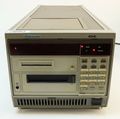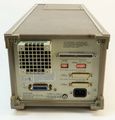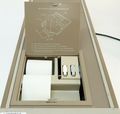4041
The Tektronix 4041 is a small, BASIC-programmable computer designed as a GPIB instrument controller. It was introduced in 1982.
Standard built-in components included a 20-character alphanumeric (14-segment) LED display, numeric keypad, a 20 character-per-row, 60 mm-wide thermal printer, a DC-100 cartridge tape drive, and a real-time clock. Interfaces included one or two GPIB and RS-232 interfaces, and an optional SCSI bus to connect diskette and hard drives. RAM could be ordered between 64k and 512k Bytes. The CPU in the 4041 is a Motorola 68000.
The base model was equipped only to execute pre-tokenized BASIC programs stored on cassette or in ROM. To develop programs, a 4041 with option 30 was needed. Option 31 added a full alphanumeric keyboard although the catalog recommended a CRT terminal for editing programs.
Option 01 added second GPIB and RS-232 ports, while option 03 added the SCSI interface and an RS-232 port.
The 4041 has a stand-alone enclosure but matches the height of TM5000 enclosures. Mounting kits allowed installation of a 4041 plus a TM5003 or a 4041 plus a 4041DDU disk unit side-by-side in a 19" rack.
The front panel contains a socket to connect the keyboard. It uses the same 4-pin LEMO S-series connector as used for the power supply connections of many Tek probes.
See Also
Documents Referencing 4041
| Document | Class | Title | Authors | Year | Links |
|---|---|---|---|---|---|
| Tekscope 1981 V13 N3.pdf | Article | TM 5000-A New Family of IEEE-488 Programmable Instruments | Bob Metzler | 1981 | 4041 • TM5003 • TM5006 • PS5010 • FG5010 • DC5010 • DM5010 • MI5010 • MX5010 • SI5010 • 50M30 • 50M40 • 50M70 |
| 75-W-5972.pdf | Article | MP2902 Performs a Variety of Audio Tests ... without Programming | 1985 | MP2902 • 4041 • AA5001 • SG5010 • DC5010 • 4105 | |
| Handshake spring 1986.pdf | Article | Audio analyzer system creates automatic test programs – without programming | Paul Wallen • Adolfo Rodriguez | 1986 | MP2902 • 4041 • AA5001 • 4105 • SG5010 |
| Handshake spring 1986.pdf | Article | Digital pulse-echo techniques for advanced composites | John L. Cline • R.L. Carlsen | 1986 | 7A16P • 7612D • 624 • 4041 • 4907 • MI5010 • 50M30 • TM5003 |
| Handshake spring 1986.pdf | Article | Tektronix 4041 Plus and 4041DDU | 1986 | 4041 • 4041DDU |
Pictures
-
-
Opt.03 interface (with SCSI and 2nd RS-232 interface), rear
-
Front
-
Rear
-
Top
-
Display Detail






